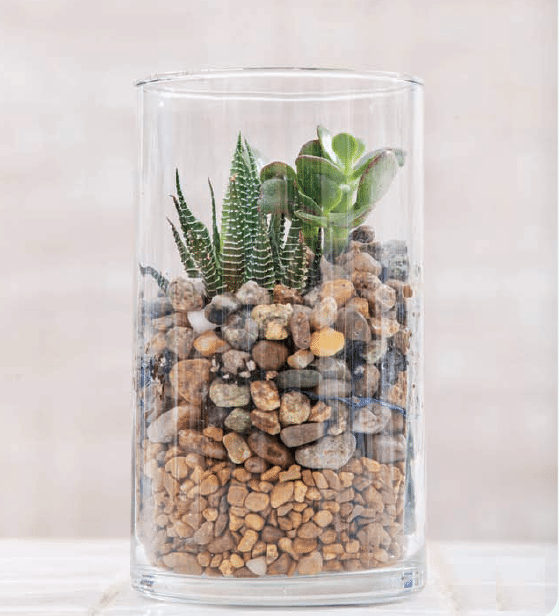By Annie Spiegelman, the Dirt Diva
Calling all of you crafty plant lovers! Here is a simple homemade gift idea that you can create for friends and family who may crave a bit of indoor nature on their desk. New York Botanical Garden terrarium designer, Maria Colletti, has a new book titled Terrariums: Gardens Under Glass.
Colletti is a terrarium purist. She likes designs that mimic the natural world—desert, woodland, bog or tropical jungle—and she emphasizes tone, texture and architectural detail. With just the tweak of a leaf or a plant one shade or direction, she argues, a terrarium can come alive. “It’s the little things that bring joy,” Colletti says.
Why a terrarium? “Terrariums are a wonderful way to return to the beautiful world we see around us in parks, gardens, historic estates, seashores, forests and deserts,” Colletti says. “But to do it indoors, as we crave the natural world in our homes and workplaces.”
Though the author doesn’t shy away from complex terrariums (she has a Victorian terrarium in her living room that’s designed to mimic the Abby Aldrich Rockefeller Garden in Seal Harbor, Maine), her book has DIY projects for the novice as well as the expert. She wrote the book for the reader who may be thinking, “I want a new craft. I want a living thing near me that I can see every day. Maybe I need it to take up a very little amount of my free time.” Free time. Yes! I’m not so crafty, so I chose one of her simplest designs, the Soilless Pebble Display with succulents. It came out surprisingly well.
How to make a small tower of succulent and stone:
Materials:
- Succulents (pictured here are jade plants—Crassula and Haworthia)
- Glass container
- Aquarium gravel
- River stones
- Pea gravel topping
- Paper divider
Step 1. Arrange the gravel and river stones on the bottom half of the glass. Use a paper divider to separate materials. (This way if any soil spills down from the plant’s root ball, it will not ruin the layered arrangement.)
Step 2. With a spoon, carefully remove the plants from the potting mix in their original container, working to keep the root ball intact and still in a bit of soil. Gently place each plant into the narrow cylinder.
Step 3. Fill in the top layer with some pea gravel that has a slightly different but natural color.
If possible, place near an east-facing window so it can bathe in the morning sun.
Peer in through the top and around the sides to admire the symmetry, structure and placement of your plants, and adore them.
Maintenance:
“I am one of those people who thinks about plants 24/7,” Colletti admits. “I’m sure everyone does not spend their day obsessed with their plant collection. Well, maybe a few of you do.” Count me in. I’m a horticultural daydreamer. The good news is that there is very little maintenance work to be done. With these succulent terrariums, all you need to do is squirt a few bursts of water into the roots every few weeks. You can achieve this with a spray bottle with a mister setting on the top. Or, if you want to be fancy, Colletti recommends using a long funnel for cylinder-shaped vessels. Trickle the smallest amount of water down the tube of the funnel until it’s at the plant’s roots. One ounce should be plenty of water.
Troubleshooting:
Some signs to look for: Are your plants leaning sideways? Plants receiving light from only one direction will gradually face that way. Stop tormenting your plants! Turn your terrarium occasionally.
Is there a white cottony substance underneath the leaves? Mealybugs especially adore jade plants, and feed on their succulent leaves. Dip a cotton swab into rubbing alcohol and dab the insects to physically remove them. Do this weekly if they become a problem. Then monthly.
Are there yellow, dried, dead or black leaves that have fallen off the plants? Yes, you should feel horribly guilty. Your plants hate you! Actually Coletti is much calmer and says to remove the sad leaves. If the soil is dry around the root ball, mist it. Maybe the terrarium has been baked by the hard sun. Try moving it away from the sun temporarily. Black leaves mean the opposite; too much water and not enough light.
“Some terrariums will live contently without being touched for months,” the author says. “But pay attention! This can be a delicate balance. The ultimate goal is to reach a state of equilibrium; then hands off and enjoy. The other ultimate goal is to experiment, have fun and enjoy for years on end.”
For more, check out Colletti’s website at green-terrariums.com.
Here’s a fun little fact for you fellow plant geeks: Crafty plant nerd Charles Darwin created terrariums in the 1830s! He sailed around the world on the HMS Beagle from 1832 to 1836, including a trip to the Galapagos Islands. Darwin and his team brought back botanicals that were kept alive on the ship because the explorers transported their findings—from the jungles of faraway continents and back to civilization—in large, enclosed glass jars.








